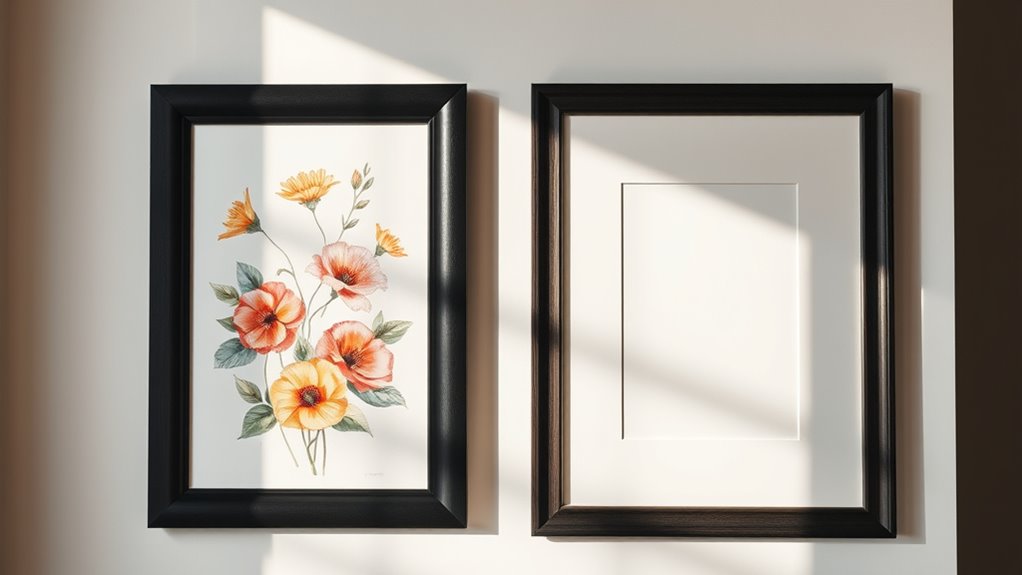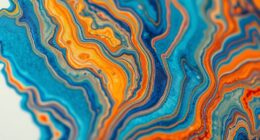When choosing between mounting and matting, consider what best protects and displays your artwork. Mounting secures the piece directly to a backing, offering stability but risking damage if not done properly. Matting adds a stylish border, protecting the art from glass and emphasizing it visually. Your decision depends on style, protection needs, and budget. To find out which option suits your artwork and decor, explore the key differences and benefits further.
Key Takeaways
- Mounting secures artwork directly to a backing, providing stability and protection, while matting creates a visual buffer around the piece.
- Mounting methods impact long-term preservation, whereas matting enhances visual appeal and highlights artwork details.
- Choose mounting for durability and protection; opt for matting when emphasizing visual contrast and style.
- Material selection for both mounting and matting affects cost, durability, and preservation quality.
- Consider artwork style, display environment, and aesthetic goals to determine whether mounting or matting—or a combination—is best.
Understanding Mounting Techniques and Materials

Understanding mounting techniques and materials is vital for effectively displaying and preserving artwork. When choosing how to mount your piece, consider glass types—such as float glass or acrylic—that influence clarity and protection. The right glass can enhance colors and reduce glare, making your artwork stand out. Framing styles also play a significant role; sleek modern frames suit contemporary art, while ornate styles complement classic pieces. The mounting method, whether using adhesive, hinging, or framing behind glass, affects how well your artwork is preserved and showcased. Selecting appropriate materials ensures longevity and enhances visual appeal. Additionally, understanding mounting techniques helps you select options that prevent damage and facilitate easy display adjustments over time. By understanding these options, you can make informed decisions that highlight your artwork’s beauty and protect it over time.
The Benefits and Drawbacks of Matting
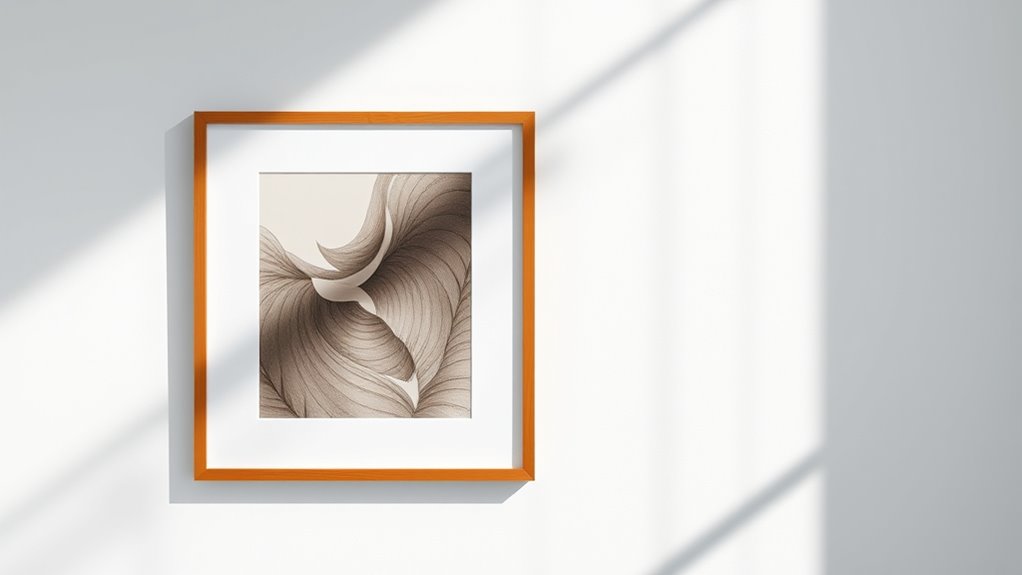
Matting offers a simple yet effective way to enhance and protect your artwork, providing a visual buffer that separates the piece from the frame or glass. It can highlight your artwork’s details and create contrast, especially with carefully chosen color coordination. However, matting also has drawbacks. It can add to the cost and may obscure parts of your art if not selected properly. When considering frame styles, some frames work better with wider or more decorative mats, while others suit minimal designs. Proper matting can also prevent damage from glass contact and help preserve your artwork over time. But, if not chosen thoughtfully, matting might clash with your art or overwhelm its visual impact. A clear understanding of cost variances can help in budgeting for framing options to ensure quality without overspending. Balance these benefits and drawbacks to make the best choice.
Aesthetic Considerations and Style Compatibility
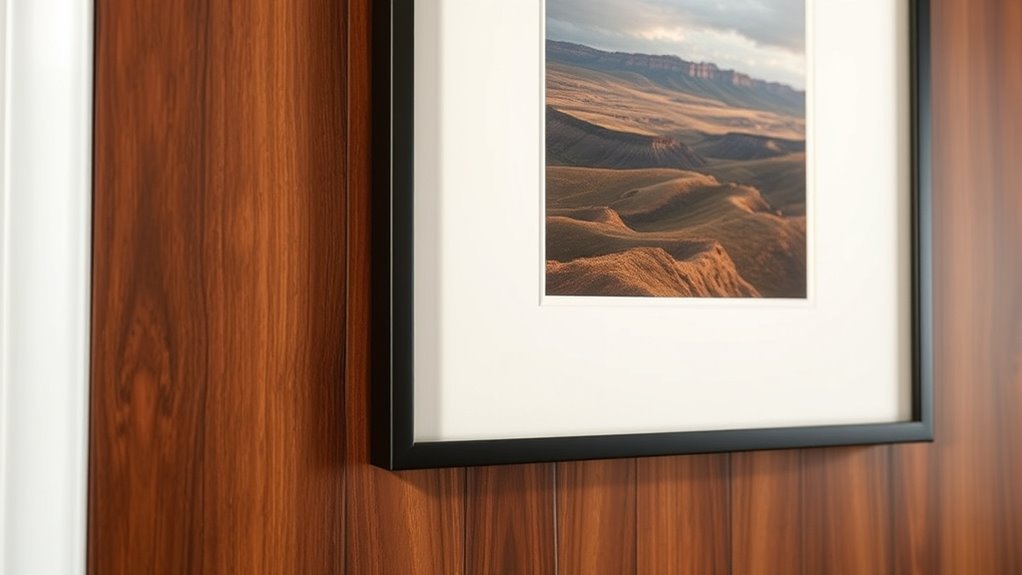
Choosing the right matting style is essential for guaranteeing your artwork complements your overall decor and personal aesthetic. Consider your frame color—neutral tones can create a subtle, sophisticated look, while bold colors make a statement. Match the matting to your wall texture; smooth walls pair well with sleek, modern mats, while textured walls benefit from more layered, dimensional mats that add depth. Think about the style of your space—classic, contemporary, or eclectic—and select a mat that enhances that mood. The mat’s color, width, and texture should harmonize with your frame and environment, creating a cohesive presentation. By paying attention to these aesthetic details, you guarantee your artwork becomes a seamless part of your decor. Incorporating Cultural Celebrations themes can also add a unique touch that reflects your personal style and interests.
Cost, Durability, and Long-Term Preservation

When selecting matting for your artwork, taking into account cost, durability, and long-term preservation is vital to guarantee your investment lasts. Different pricing options can impact your budget, so explore affordable yet quality materials. Durability matters; choose acid-free or archival-quality mats to prevent deterioration over time. Long-term preservation also involves environmental impact—opt for eco-friendly options that reduce harmful chemicals and waste. Be aware that higher-quality mats often cost more but offer better protection. Balancing cost with durability ensures your artwork remains pristine. Here are key points to consider:
- Affordable pricing options without sacrificing quality
- Acid-free, archival-quality materials for preservation
- Eco-friendly and environmentally conscious choices
- Resistance to fading, warping, or discoloration
- Long-term value vs. initial cost
- Incorporating Glycolic Acid in skincare routines can help maintain a fresh, healthy appearance of your artwork’s presentation surface over time.
Making the Best Choice for Your Artwork or Photos
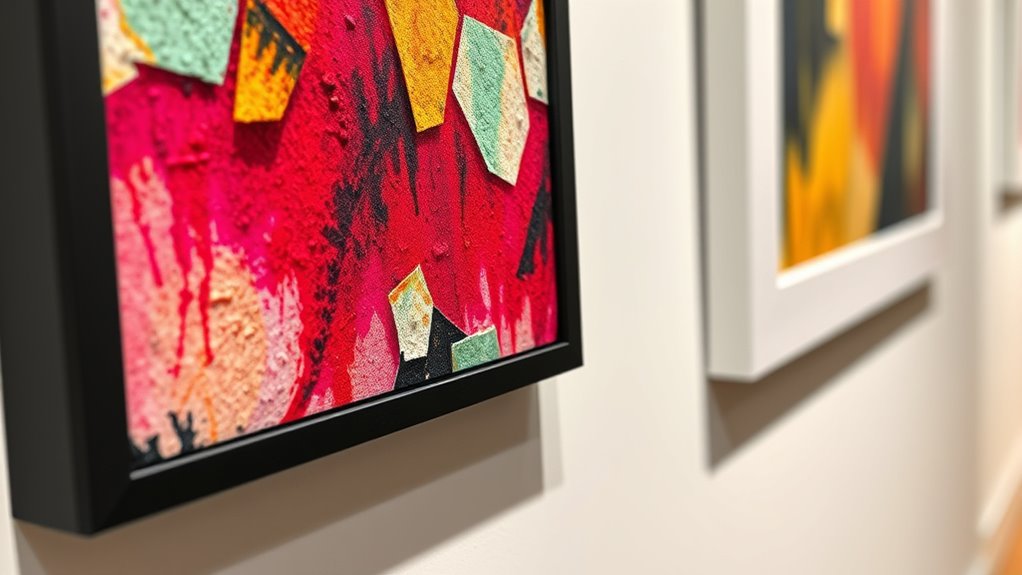
Selecting the right matting for your artwork or photos depends on balancing aesthetic appeal with practical considerations. Your choice influences framing options and how your pieces will look in various display environments. Consider whether you want a simple, clean border or something more elaborate to enhance the artwork’s style. Think about the display environment—glossy surfaces might require matte mats to reduce glare, while bright, vibrant images may benefit from neutral tones that don’t compete with the art. The mat’s color, width, and texture all impact the overall presentation. By evaluating your artwork’s characteristics and where it will be displayed, you ensure a polished, professional look that highlights your piece’s strengths while fitting seamlessly into its environment. Additionally, understanding emotional support can help you make confident choices, especially if you’re feeling overwhelmed by the options.
Frequently Asked Questions
How Do Mounting and Matting Impact Artwork Protection?
Mounting and matting enhance artwork protection by providing a buffer against damage and environmental factors. Using acid-free materials guarantees your artwork stays preserved over time, preventing deterioration. UV protection is vital, especially for mounted or matted pieces, as it shields against harmful light that can fade colors. Proper mounting and matting help maintain your artwork’s integrity, making it last longer while enhancing its presentation and visual appeal.
Can Mounting or Matting Influence Framing Options?
Did you know that 85% of art collectors prefer custom framing that complements mounting or matting choices? Yes, mounting and matting can profoundly influence your framing options, affecting display aesthetics and preservation. When you select mounting or matting, you can opt for specific framing styles that enhance your artwork’s look and protection. This customization ensures your piece fits perfectly, elevating its visual appeal while maintaining its integrity over time.
Are There Specific Conditions Where One Method Is Preferred?
When deciding between mounting and matting, consider gallery displays and archival standards. You might prefer mounting for a sleek, modern look that enhances durability, especially with archival materials to prevent damage. Matting is ideal when you want to create visual separation and preserve artwork integrity, particularly in traditional gallery settings. Choose based on your display environment, the artwork’s needs, and the importance of long-term preservation.
How Do Environmental Factors Affect Mounted Versus Matted Pieces?
Environmental factors like climate sensitivity and light exposure critically impact your art presentation choices. If your piece is climate-sensitive, mounting offers stability and protection against humidity changes, while matting helps control light exposure, preventing fading. You should consider these factors when deciding, as mounting provides durability in fluctuating conditions, and matting helps preserve colors by filtering light. Understanding your environment ensures your artwork remains vibrant and well-preserved over time.
What Are the Environmental Sustainability Considerations for Each Method?
Think of your artwork’s future as a seedling needing care. When you choose eco-friendly adhesives and biodegradable materials, you nurture sustainability. For mounting, opt for biodegradable backing and minimal plastics; for matting, select recycled papers and dyes. Both methods can reduce environmental impact by prioritizing renewable resources and safe adhesives. Your choices influence not just the piece’s presentation but also its legacy—protecting our planet, one sustainable step at a time.
Conclusion
Ultimately, choosing between mounting and matting shapes how your artwork breathes and shines. Imagine your piece framed like a jewel—mounted for strength and presence, or matted for elegance and depth. Picture the gallery wall where each detail whispers your story. Trust your style and needs to guide you, turning your display into a mesmerizing visual journey. With the right choice, your art will stand proud, ready to enchant every viewer who steps into your world.
